Business & the Business Environment Assignment - Sainsbury
VerifiedAdded on 2021/01/01
|16
|5188
|277
AI Summary
Contribute Materials
Your contribution can guide someone’s learning journey. Share your
documents today.
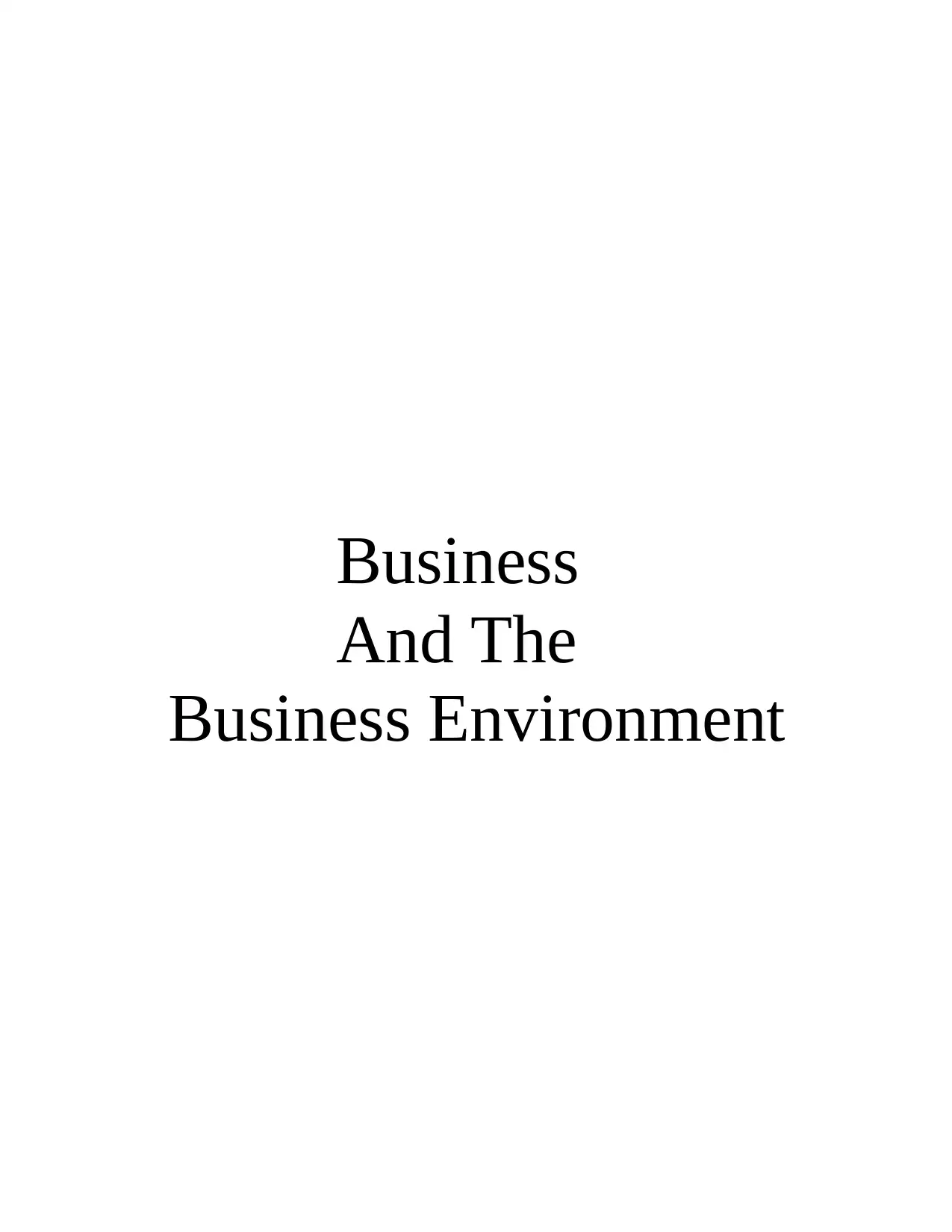
Business
And The
Business Environment
And The
Business Environment
Secure Best Marks with AI Grader
Need help grading? Try our AI Grader for instant feedback on your assignments.
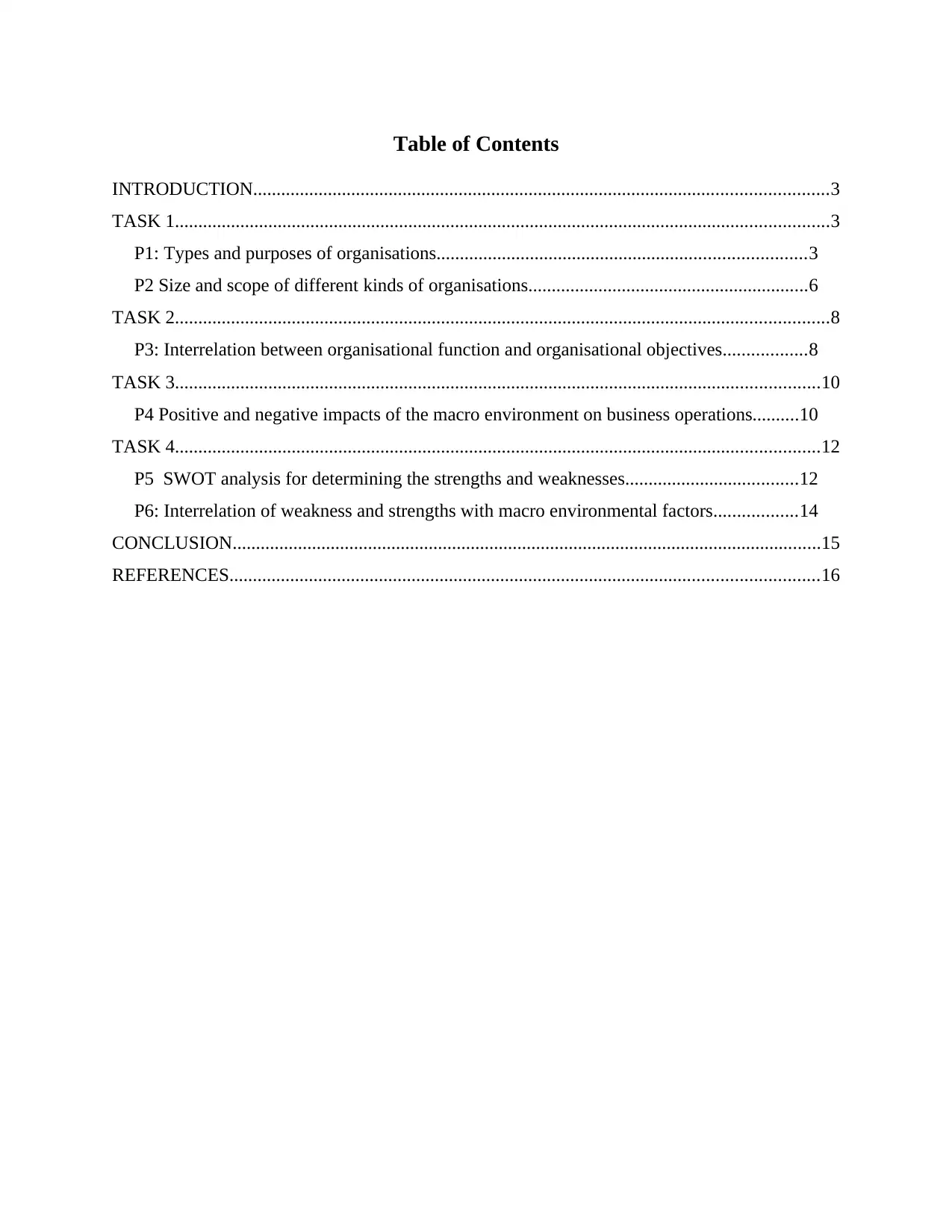
Table of Contents
INTRODUCTION...........................................................................................................................3
TASK 1............................................................................................................................................3
P1: Types and purposes of organisations...............................................................................3
P2 Size and scope of different kinds of organisations............................................................6
TASK 2............................................................................................................................................8
P3: Interrelation between organisational function and organisational objectives..................8
TASK 3..........................................................................................................................................10
P4 Positive and negative impacts of the macro environment on business operations..........10
TASK 4..........................................................................................................................................12
P5 SWOT analysis for determining the strengths and weaknesses.....................................12
P6: Interrelation of weakness and strengths with macro environmental factors..................14
CONCLUSION..............................................................................................................................15
REFERENCES..............................................................................................................................16
INTRODUCTION...........................................................................................................................3
TASK 1............................................................................................................................................3
P1: Types and purposes of organisations...............................................................................3
P2 Size and scope of different kinds of organisations............................................................6
TASK 2............................................................................................................................................8
P3: Interrelation between organisational function and organisational objectives..................8
TASK 3..........................................................................................................................................10
P4 Positive and negative impacts of the macro environment on business operations..........10
TASK 4..........................................................................................................................................12
P5 SWOT analysis for determining the strengths and weaknesses.....................................12
P6: Interrelation of weakness and strengths with macro environmental factors..................14
CONCLUSION..............................................................................................................................15
REFERENCES..............................................................................................................................16
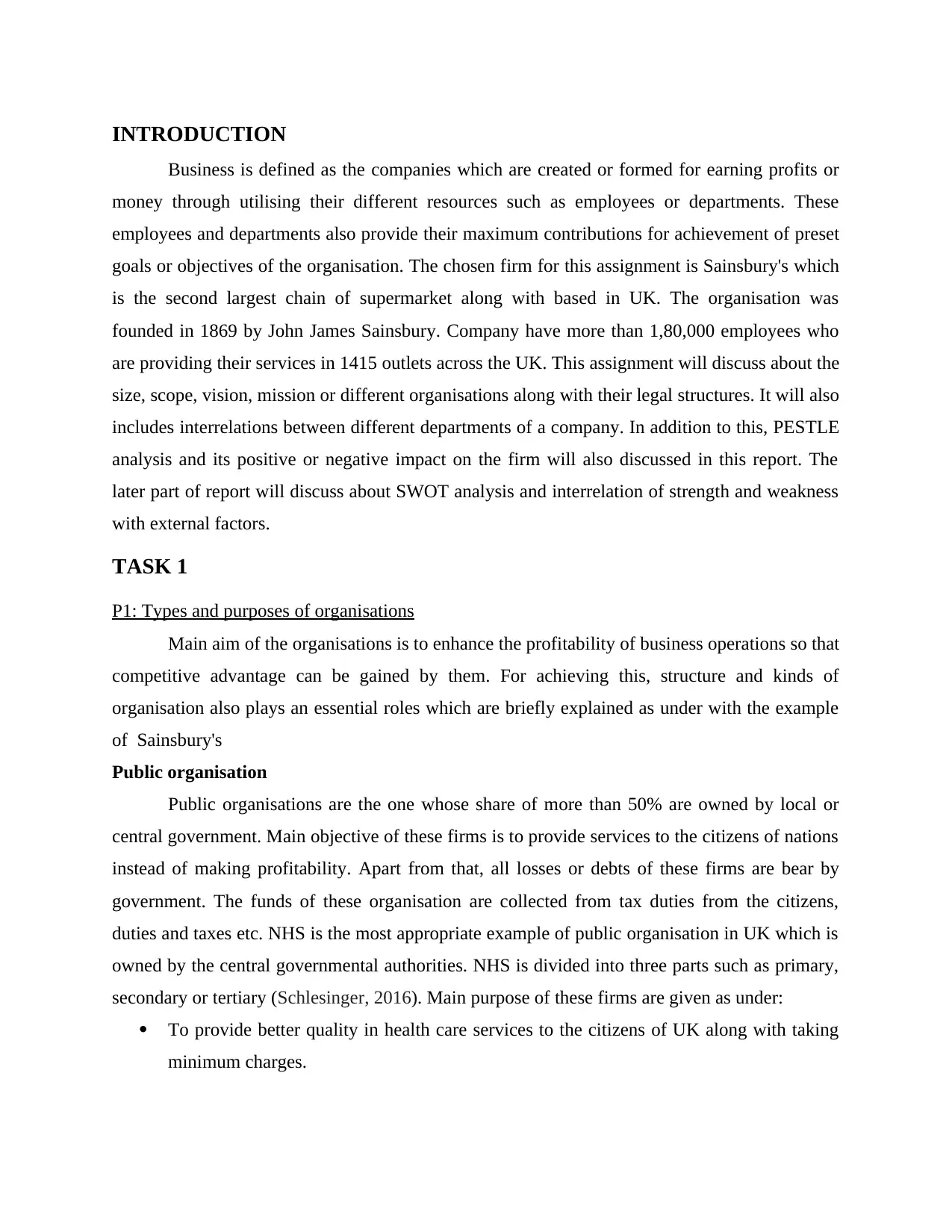
INTRODUCTION
Business is defined as the companies which are created or formed for earning profits or
money through utilising their different resources such as employees or departments. These
employees and departments also provide their maximum contributions for achievement of preset
goals or objectives of the organisation. The chosen firm for this assignment is Sainsbury's which
is the second largest chain of supermarket along with based in UK. The organisation was
founded in 1869 by John James Sainsbury. Company have more than 1,80,000 employees who
are providing their services in 1415 outlets across the UK. This assignment will discuss about the
size, scope, vision, mission or different organisations along with their legal structures. It will also
includes interrelations between different departments of a company. In addition to this, PESTLE
analysis and its positive or negative impact on the firm will also discussed in this report. The
later part of report will discuss about SWOT analysis and interrelation of strength and weakness
with external factors.
TASK 1
P1: Types and purposes of organisations
Main aim of the organisations is to enhance the profitability of business operations so that
competitive advantage can be gained by them. For achieving this, structure and kinds of
organisation also plays an essential roles which are briefly explained as under with the example
of Sainsbury's
Public organisation
Public organisations are the one whose share of more than 50% are owned by local or
central government. Main objective of these firms is to provide services to the citizens of nations
instead of making profitability. Apart from that, all losses or debts of these firms are bear by
government. The funds of these organisation are collected from tax duties from the citizens,
duties and taxes etc. NHS is the most appropriate example of public organisation in UK which is
owned by the central governmental authorities. NHS is divided into three parts such as primary,
secondary or tertiary (Schlesinger, 2016). Main purpose of these firms are given as under:
To provide better quality in health care services to the citizens of UK along with taking
minimum charges.
Business is defined as the companies which are created or formed for earning profits or
money through utilising their different resources such as employees or departments. These
employees and departments also provide their maximum contributions for achievement of preset
goals or objectives of the organisation. The chosen firm for this assignment is Sainsbury's which
is the second largest chain of supermarket along with based in UK. The organisation was
founded in 1869 by John James Sainsbury. Company have more than 1,80,000 employees who
are providing their services in 1415 outlets across the UK. This assignment will discuss about the
size, scope, vision, mission or different organisations along with their legal structures. It will also
includes interrelations between different departments of a company. In addition to this, PESTLE
analysis and its positive or negative impact on the firm will also discussed in this report. The
later part of report will discuss about SWOT analysis and interrelation of strength and weakness
with external factors.
TASK 1
P1: Types and purposes of organisations
Main aim of the organisations is to enhance the profitability of business operations so that
competitive advantage can be gained by them. For achieving this, structure and kinds of
organisation also plays an essential roles which are briefly explained as under with the example
of Sainsbury's
Public organisation
Public organisations are the one whose share of more than 50% are owned by local or
central government. Main objective of these firms is to provide services to the citizens of nations
instead of making profitability. Apart from that, all losses or debts of these firms are bear by
government. The funds of these organisation are collected from tax duties from the citizens,
duties and taxes etc. NHS is the most appropriate example of public organisation in UK which is
owned by the central governmental authorities. NHS is divided into three parts such as primary,
secondary or tertiary (Schlesinger, 2016). Main purpose of these firms are given as under:
To provide better quality in health care services to the citizens of UK along with taking
minimum charges.
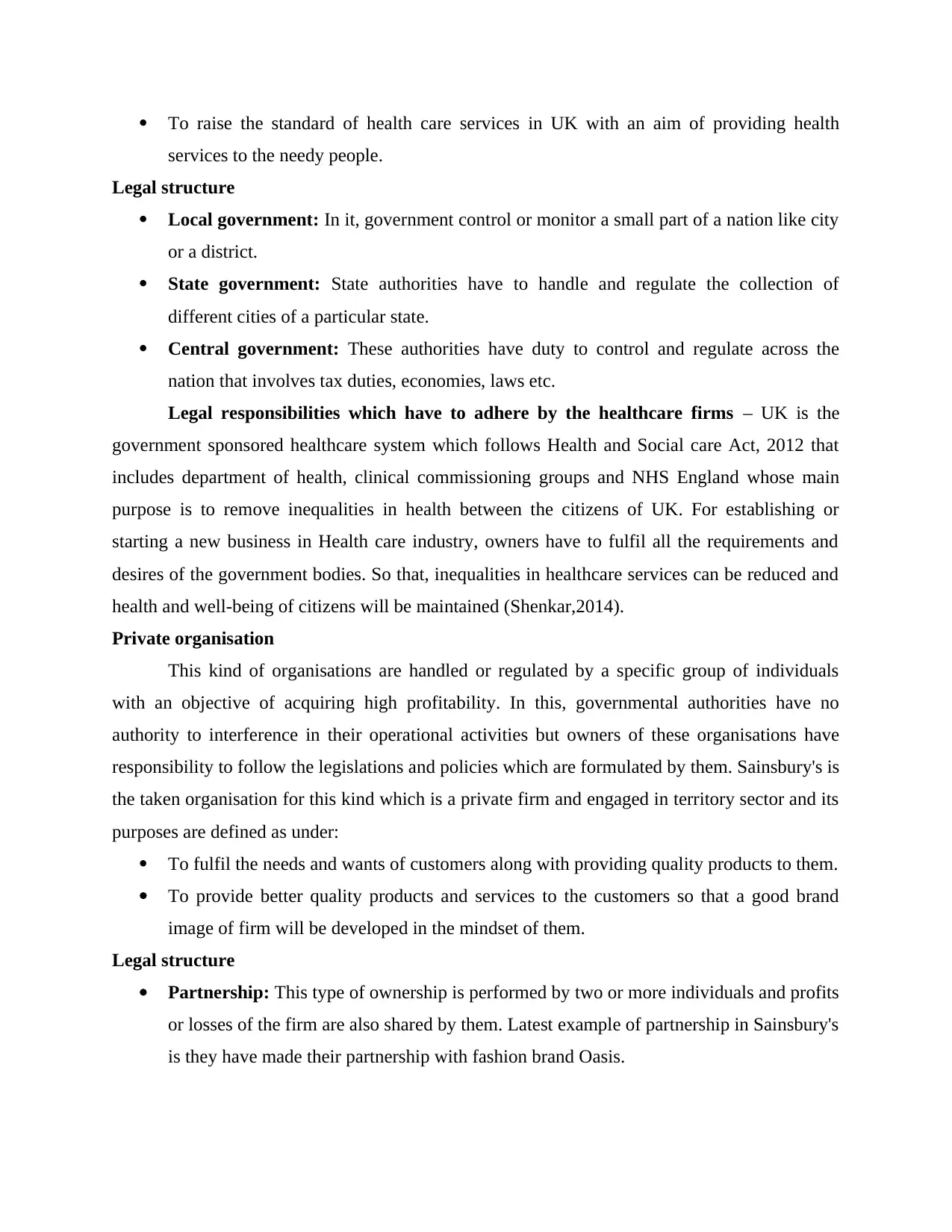
To raise the standard of health care services in UK with an aim of providing health
services to the needy people.
Legal structure
Local government: In it, government control or monitor a small part of a nation like city
or a district.
State government: State authorities have to handle and regulate the collection of
different cities of a particular state.
Central government: These authorities have duty to control and regulate across the
nation that involves tax duties, economies, laws etc.
Legal responsibilities which have to adhere by the healthcare firms – UK is the
government sponsored healthcare system which follows Health and Social care Act, 2012 that
includes department of health, clinical commissioning groups and NHS England whose main
purpose is to remove inequalities in health between the citizens of UK. For establishing or
starting a new business in Health care industry, owners have to fulfil all the requirements and
desires of the government bodies. So that, inequalities in healthcare services can be reduced and
health and well-being of citizens will be maintained (Shenkar,2014).
Private organisation
This kind of organisations are handled or regulated by a specific group of individuals
with an objective of acquiring high profitability. In this, governmental authorities have no
authority to interference in their operational activities but owners of these organisations have
responsibility to follow the legislations and policies which are formulated by them. Sainsbury's is
the taken organisation for this kind which is a private firm and engaged in territory sector and its
purposes are defined as under:
To fulfil the needs and wants of customers along with providing quality products to them.
To provide better quality products and services to the customers so that a good brand
image of firm will be developed in the mindset of them.
Legal structure
Partnership: This type of ownership is performed by two or more individuals and profits
or losses of the firm are also shared by them. Latest example of partnership in Sainsbury's
is they have made their partnership with fashion brand Oasis.
services to the needy people.
Legal structure
Local government: In it, government control or monitor a small part of a nation like city
or a district.
State government: State authorities have to handle and regulate the collection of
different cities of a particular state.
Central government: These authorities have duty to control and regulate across the
nation that involves tax duties, economies, laws etc.
Legal responsibilities which have to adhere by the healthcare firms – UK is the
government sponsored healthcare system which follows Health and Social care Act, 2012 that
includes department of health, clinical commissioning groups and NHS England whose main
purpose is to remove inequalities in health between the citizens of UK. For establishing or
starting a new business in Health care industry, owners have to fulfil all the requirements and
desires of the government bodies. So that, inequalities in healthcare services can be reduced and
health and well-being of citizens will be maintained (Shenkar,2014).
Private organisation
This kind of organisations are handled or regulated by a specific group of individuals
with an objective of acquiring high profitability. In this, governmental authorities have no
authority to interference in their operational activities but owners of these organisations have
responsibility to follow the legislations and policies which are formulated by them. Sainsbury's is
the taken organisation for this kind which is a private firm and engaged in territory sector and its
purposes are defined as under:
To fulfil the needs and wants of customers along with providing quality products to them.
To provide better quality products and services to the customers so that a good brand
image of firm will be developed in the mindset of them.
Legal structure
Partnership: This type of ownership is performed by two or more individuals and profits
or losses of the firm are also shared by them. Latest example of partnership in Sainsbury's
is they have made their partnership with fashion brand Oasis.
Secure Best Marks with AI Grader
Need help grading? Try our AI Grader for instant feedback on your assignments.
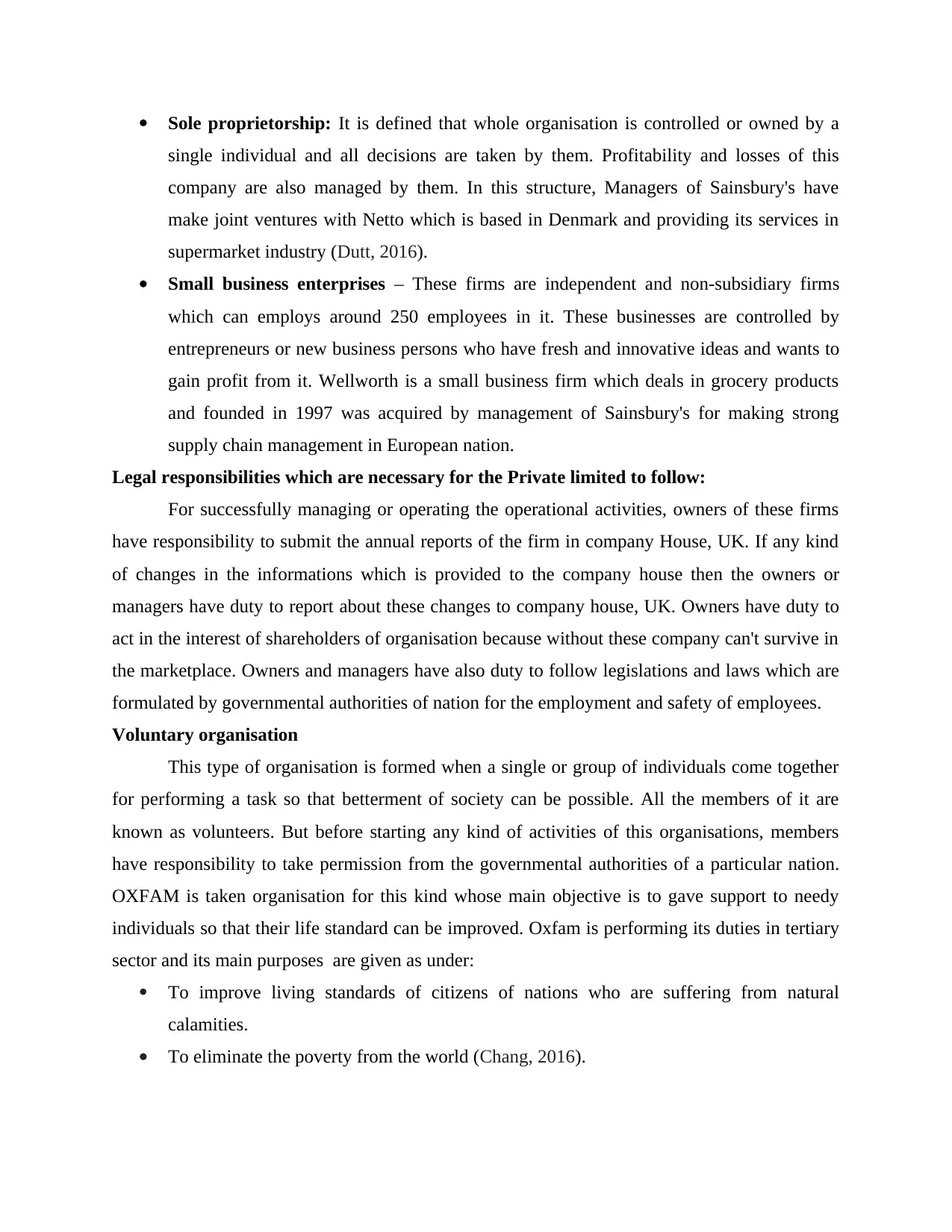
Sole proprietorship: It is defined that whole organisation is controlled or owned by a
single individual and all decisions are taken by them. Profitability and losses of this
company are also managed by them. In this structure, Managers of Sainsbury's have
make joint ventures with Netto which is based in Denmark and providing its services in
supermarket industry (Dutt, 2016).
Small business enterprises – These firms are independent and non-subsidiary firms
which can employs around 250 employees in it. These businesses are controlled by
entrepreneurs or new business persons who have fresh and innovative ideas and wants to
gain profit from it. Wellworth is a small business firm which deals in grocery products
and founded in 1997 was acquired by management of Sainsbury's for making strong
supply chain management in European nation.
Legal responsibilities which are necessary for the Private limited to follow:
For successfully managing or operating the operational activities, owners of these firms
have responsibility to submit the annual reports of the firm in company House, UK. If any kind
of changes in the informations which is provided to the company house then the owners or
managers have duty to report about these changes to company house, UK. Owners have duty to
act in the interest of shareholders of organisation because without these company can't survive in
the marketplace. Owners and managers have also duty to follow legislations and laws which are
formulated by governmental authorities of nation for the employment and safety of employees.
Voluntary organisation
This type of organisation is formed when a single or group of individuals come together
for performing a task so that betterment of society can be possible. All the members of it are
known as volunteers. But before starting any kind of activities of this organisations, members
have responsibility to take permission from the governmental authorities of a particular nation.
OXFAM is taken organisation for this kind whose main objective is to gave support to needy
individuals so that their life standard can be improved. Oxfam is performing its duties in tertiary
sector and its main purposes are given as under:
To improve living standards of citizens of nations who are suffering from natural
calamities.
To eliminate the poverty from the world (Chang, 2016).
single individual and all decisions are taken by them. Profitability and losses of this
company are also managed by them. In this structure, Managers of Sainsbury's have
make joint ventures with Netto which is based in Denmark and providing its services in
supermarket industry (Dutt, 2016).
Small business enterprises – These firms are independent and non-subsidiary firms
which can employs around 250 employees in it. These businesses are controlled by
entrepreneurs or new business persons who have fresh and innovative ideas and wants to
gain profit from it. Wellworth is a small business firm which deals in grocery products
and founded in 1997 was acquired by management of Sainsbury's for making strong
supply chain management in European nation.
Legal responsibilities which are necessary for the Private limited to follow:
For successfully managing or operating the operational activities, owners of these firms
have responsibility to submit the annual reports of the firm in company House, UK. If any kind
of changes in the informations which is provided to the company house then the owners or
managers have duty to report about these changes to company house, UK. Owners have duty to
act in the interest of shareholders of organisation because without these company can't survive in
the marketplace. Owners and managers have also duty to follow legislations and laws which are
formulated by governmental authorities of nation for the employment and safety of employees.
Voluntary organisation
This type of organisation is formed when a single or group of individuals come together
for performing a task so that betterment of society can be possible. All the members of it are
known as volunteers. But before starting any kind of activities of this organisations, members
have responsibility to take permission from the governmental authorities of a particular nation.
OXFAM is taken organisation for this kind whose main objective is to gave support to needy
individuals so that their life standard can be improved. Oxfam is performing its duties in tertiary
sector and its main purposes are given as under:
To improve living standards of citizens of nations who are suffering from natural
calamities.
To eliminate the poverty from the world (Chang, 2016).
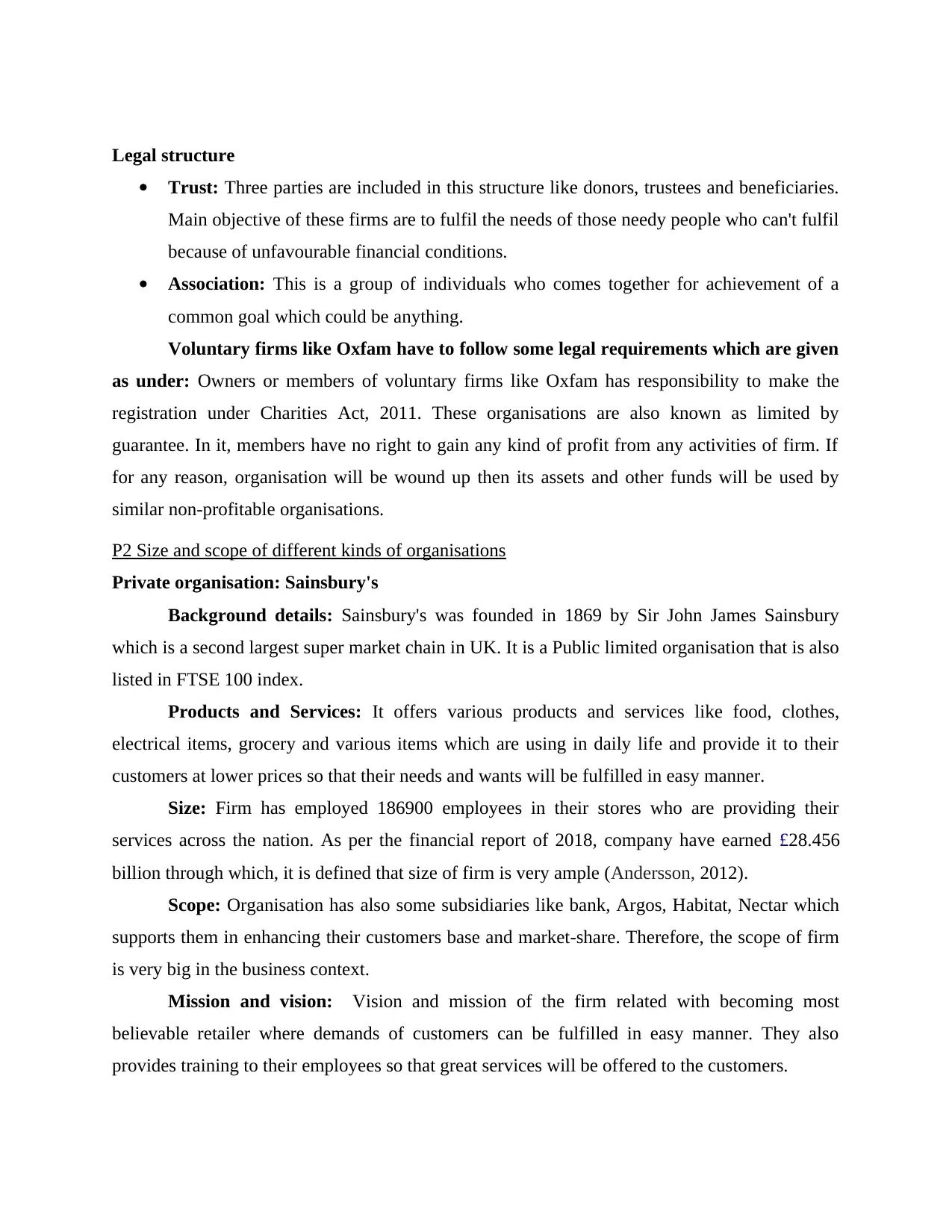
Legal structure
Trust: Three parties are included in this structure like donors, trustees and beneficiaries.
Main objective of these firms are to fulfil the needs of those needy people who can't fulfil
because of unfavourable financial conditions.
Association: This is a group of individuals who comes together for achievement of a
common goal which could be anything.
Voluntary firms like Oxfam have to follow some legal requirements which are given
as under: Owners or members of voluntary firms like Oxfam has responsibility to make the
registration under Charities Act, 2011. These organisations are also known as limited by
guarantee. In it, members have no right to gain any kind of profit from any activities of firm. If
for any reason, organisation will be wound up then its assets and other funds will be used by
similar non-profitable organisations.
P2 Size and scope of different kinds of organisations
Private organisation: Sainsbury's
Background details: Sainsbury's was founded in 1869 by Sir John James Sainsbury
which is a second largest super market chain in UK. It is a Public limited organisation that is also
listed in FTSE 100 index.
Products and Services: It offers various products and services like food, clothes,
electrical items, grocery and various items which are using in daily life and provide it to their
customers at lower prices so that their needs and wants will be fulfilled in easy manner.
Size: Firm has employed 186900 employees in their stores who are providing their
services across the nation. As per the financial report of 2018, company have earned £28.456
billion through which, it is defined that size of firm is very ample (Andersson, 2012).
Scope: Organisation has also some subsidiaries like bank, Argos, Habitat, Nectar which
supports them in enhancing their customers base and market-share. Therefore, the scope of firm
is very big in the business context.
Mission and vision: Vision and mission of the firm related with becoming most
believable retailer where demands of customers can be fulfilled in easy manner. They also
provides training to their employees so that great services will be offered to the customers.
Trust: Three parties are included in this structure like donors, trustees and beneficiaries.
Main objective of these firms are to fulfil the needs of those needy people who can't fulfil
because of unfavourable financial conditions.
Association: This is a group of individuals who comes together for achievement of a
common goal which could be anything.
Voluntary firms like Oxfam have to follow some legal requirements which are given
as under: Owners or members of voluntary firms like Oxfam has responsibility to make the
registration under Charities Act, 2011. These organisations are also known as limited by
guarantee. In it, members have no right to gain any kind of profit from any activities of firm. If
for any reason, organisation will be wound up then its assets and other funds will be used by
similar non-profitable organisations.
P2 Size and scope of different kinds of organisations
Private organisation: Sainsbury's
Background details: Sainsbury's was founded in 1869 by Sir John James Sainsbury
which is a second largest super market chain in UK. It is a Public limited organisation that is also
listed in FTSE 100 index.
Products and Services: It offers various products and services like food, clothes,
electrical items, grocery and various items which are using in daily life and provide it to their
customers at lower prices so that their needs and wants will be fulfilled in easy manner.
Size: Firm has employed 186900 employees in their stores who are providing their
services across the nation. As per the financial report of 2018, company have earned £28.456
billion through which, it is defined that size of firm is very ample (Andersson, 2012).
Scope: Organisation has also some subsidiaries like bank, Argos, Habitat, Nectar which
supports them in enhancing their customers base and market-share. Therefore, the scope of firm
is very big in the business context.
Mission and vision: Vision and mission of the firm related with becoming most
believable retailer where demands of customers can be fulfilled in easy manner. They also
provides training to their employees so that great services will be offered to the customers.
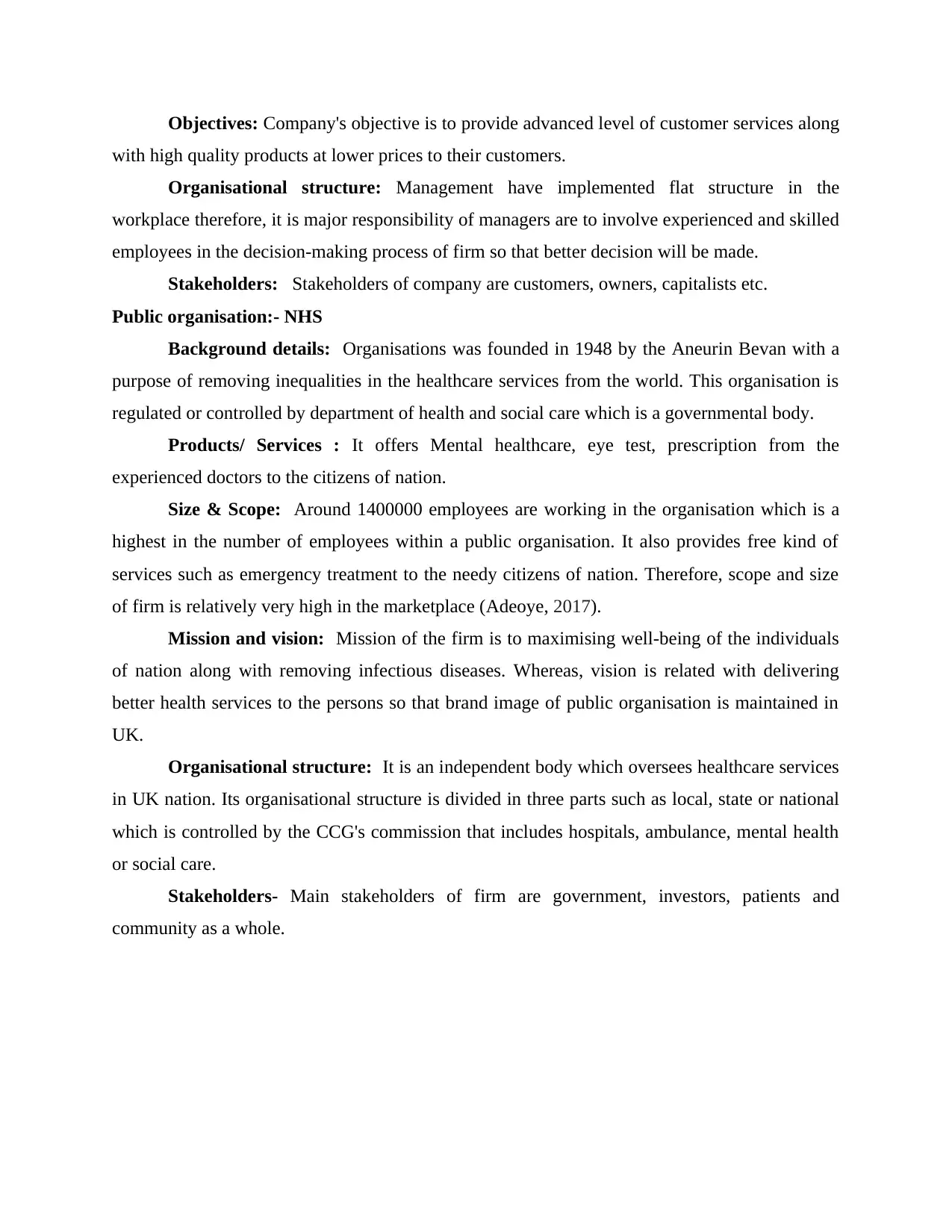
Objectives: Company's objective is to provide advanced level of customer services along
with high quality products at lower prices to their customers.
Organisational structure: Management have implemented flat structure in the
workplace therefore, it is major responsibility of managers are to involve experienced and skilled
employees in the decision-making process of firm so that better decision will be made.
Stakeholders: Stakeholders of company are customers, owners, capitalists etc.
Public organisation:- NHS
Background details: Organisations was founded in 1948 by the Aneurin Bevan with a
purpose of removing inequalities in the healthcare services from the world. This organisation is
regulated or controlled by department of health and social care which is a governmental body.
Products/ Services : It offers Mental healthcare, eye test, prescription from the
experienced doctors to the citizens of nation.
Size & Scope: Around 1400000 employees are working in the organisation which is a
highest in the number of employees within a public organisation. It also provides free kind of
services such as emergency treatment to the needy citizens of nation. Therefore, scope and size
of firm is relatively very high in the marketplace (Adeoye, 2017).
Mission and vision: Mission of the firm is to maximising well-being of the individuals
of nation along with removing infectious diseases. Whereas, vision is related with delivering
better health services to the persons so that brand image of public organisation is maintained in
UK.
Organisational structure: It is an independent body which oversees healthcare services
in UK nation. Its organisational structure is divided in three parts such as local, state or national
which is controlled by the CCG's commission that includes hospitals, ambulance, mental health
or social care.
Stakeholders- Main stakeholders of firm are government, investors, patients and
community as a whole.
with high quality products at lower prices to their customers.
Organisational structure: Management have implemented flat structure in the
workplace therefore, it is major responsibility of managers are to involve experienced and skilled
employees in the decision-making process of firm so that better decision will be made.
Stakeholders: Stakeholders of company are customers, owners, capitalists etc.
Public organisation:- NHS
Background details: Organisations was founded in 1948 by the Aneurin Bevan with a
purpose of removing inequalities in the healthcare services from the world. This organisation is
regulated or controlled by department of health and social care which is a governmental body.
Products/ Services : It offers Mental healthcare, eye test, prescription from the
experienced doctors to the citizens of nation.
Size & Scope: Around 1400000 employees are working in the organisation which is a
highest in the number of employees within a public organisation. It also provides free kind of
services such as emergency treatment to the needy citizens of nation. Therefore, scope and size
of firm is relatively very high in the marketplace (Adeoye, 2017).
Mission and vision: Mission of the firm is to maximising well-being of the individuals
of nation along with removing infectious diseases. Whereas, vision is related with delivering
better health services to the persons so that brand image of public organisation is maintained in
UK.
Organisational structure: It is an independent body which oversees healthcare services
in UK nation. Its organisational structure is divided in three parts such as local, state or national
which is controlled by the CCG's commission that includes hospitals, ambulance, mental health
or social care.
Stakeholders- Main stakeholders of firm are government, investors, patients and
community as a whole.
Paraphrase This Document
Need a fresh take? Get an instant paraphrase of this document with our AI Paraphraser
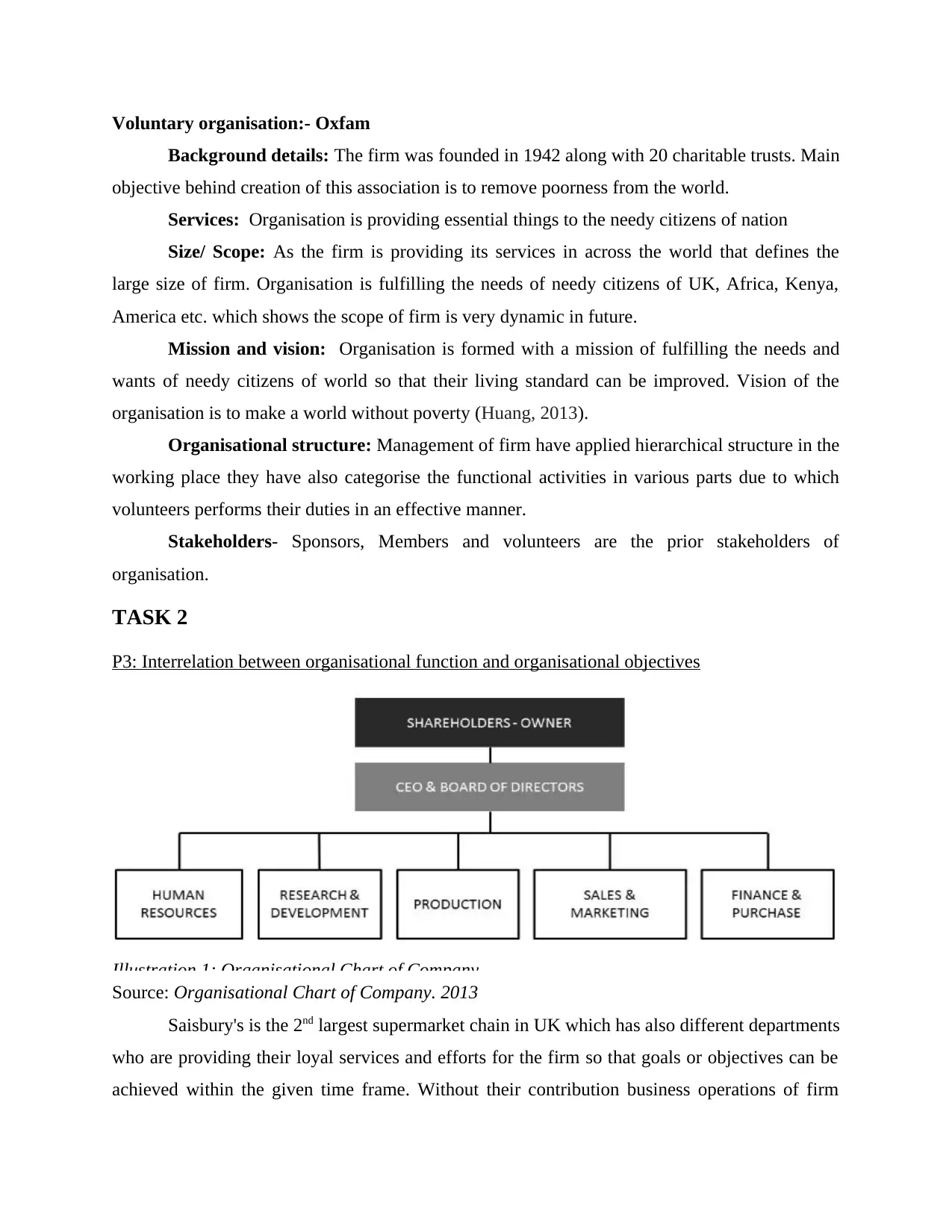
Voluntary organisation:- Oxfam
Background details: The firm was founded in 1942 along with 20 charitable trusts. Main
objective behind creation of this association is to remove poorness from the world.
Services: Organisation is providing essential things to the needy citizens of nation
Size/ Scope: As the firm is providing its services in across the world that defines the
large size of firm. Organisation is fulfilling the needs of needy citizens of UK, Africa, Kenya,
America etc. which shows the scope of firm is very dynamic in future.
Mission and vision: Organisation is formed with a mission of fulfilling the needs and
wants of needy citizens of world so that their living standard can be improved. Vision of the
organisation is to make a world without poverty (Huang, 2013).
Organisational structure: Management of firm have applied hierarchical structure in the
working place they have also categorise the functional activities in various parts due to which
volunteers performs their duties in an effective manner.
Stakeholders- Sponsors, Members and volunteers are the prior stakeholders of
organisation.
TASK 2
P3: Interrelation between organisational function and organisational objectives
Illustration 1: Organisational Chart of Company
Source: Organisational Chart of Company. 2013
Saisbury's is the 2nd largest supermarket chain in UK which has also different departments
who are providing their loyal services and efforts for the firm so that goals or objectives can be
achieved within the given time frame. Without their contribution business operations of firm
Background details: The firm was founded in 1942 along with 20 charitable trusts. Main
objective behind creation of this association is to remove poorness from the world.
Services: Organisation is providing essential things to the needy citizens of nation
Size/ Scope: As the firm is providing its services in across the world that defines the
large size of firm. Organisation is fulfilling the needs of needy citizens of UK, Africa, Kenya,
America etc. which shows the scope of firm is very dynamic in future.
Mission and vision: Organisation is formed with a mission of fulfilling the needs and
wants of needy citizens of world so that their living standard can be improved. Vision of the
organisation is to make a world without poverty (Huang, 2013).
Organisational structure: Management of firm have applied hierarchical structure in the
working place they have also categorise the functional activities in various parts due to which
volunteers performs their duties in an effective manner.
Stakeholders- Sponsors, Members and volunteers are the prior stakeholders of
organisation.
TASK 2
P3: Interrelation between organisational function and organisational objectives
Illustration 1: Organisational Chart of Company
Source: Organisational Chart of Company. 2013
Saisbury's is the 2nd largest supermarket chain in UK which has also different departments
who are providing their loyal services and efforts for the firm so that goals or objectives can be
achieved within the given time frame. Without their contribution business operations of firm
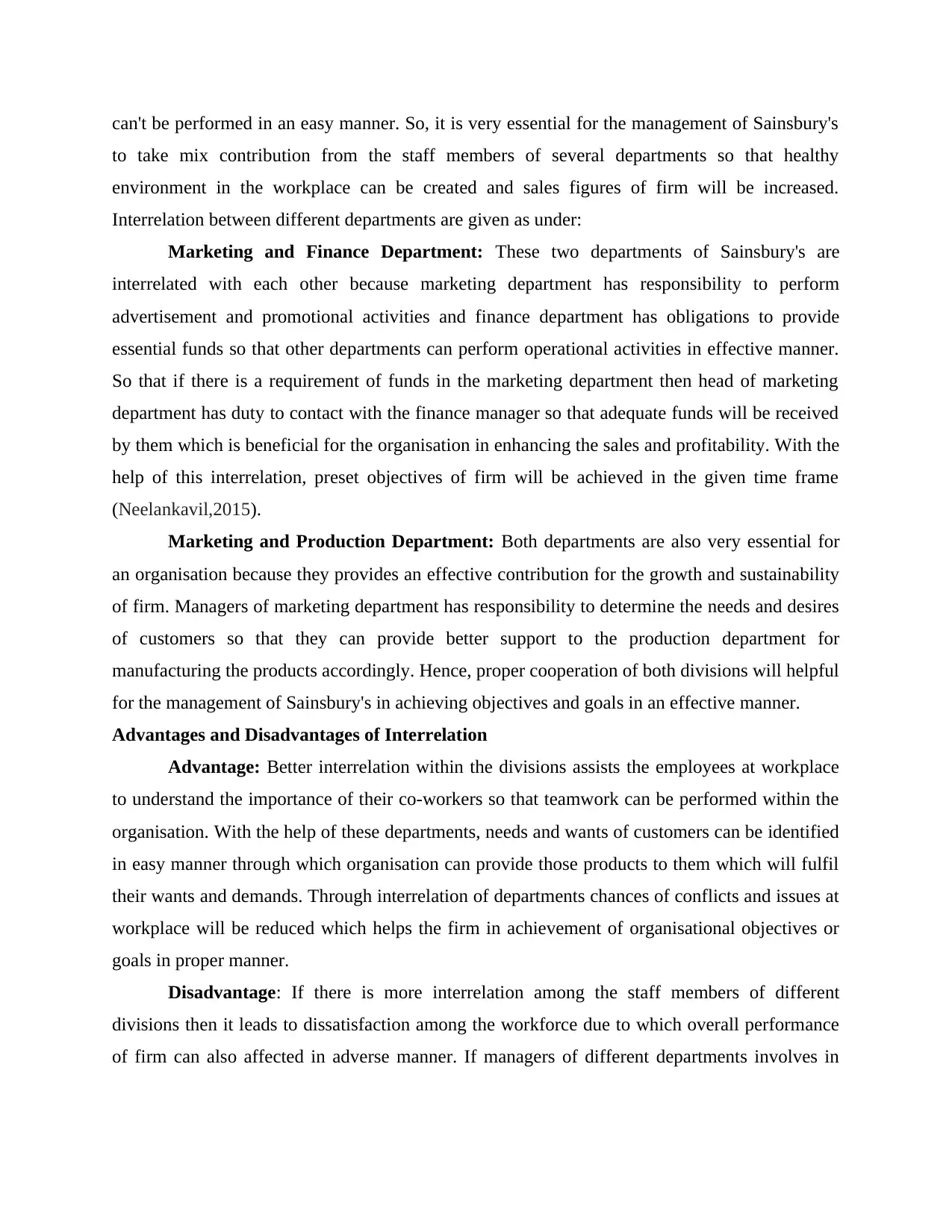
can't be performed in an easy manner. So, it is very essential for the management of Sainsbury's
to take mix contribution from the staff members of several departments so that healthy
environment in the workplace can be created and sales figures of firm will be increased.
Interrelation between different departments are given as under:
Marketing and Finance Department: These two departments of Sainsbury's are
interrelated with each other because marketing department has responsibility to perform
advertisement and promotional activities and finance department has obligations to provide
essential funds so that other departments can perform operational activities in effective manner.
So that if there is a requirement of funds in the marketing department then head of marketing
department has duty to contact with the finance manager so that adequate funds will be received
by them which is beneficial for the organisation in enhancing the sales and profitability. With the
help of this interrelation, preset objectives of firm will be achieved in the given time frame
(Neelankavil,2015).
Marketing and Production Department: Both departments are also very essential for
an organisation because they provides an effective contribution for the growth and sustainability
of firm. Managers of marketing department has responsibility to determine the needs and desires
of customers so that they can provide better support to the production department for
manufacturing the products accordingly. Hence, proper cooperation of both divisions will helpful
for the management of Sainsbury's in achieving objectives and goals in an effective manner.
Advantages and Disadvantages of Interrelation
Advantage: Better interrelation within the divisions assists the employees at workplace
to understand the importance of their co-workers so that teamwork can be performed within the
organisation. With the help of these departments, needs and wants of customers can be identified
in easy manner through which organisation can provide those products to them which will fulfil
their wants and demands. Through interrelation of departments chances of conflicts and issues at
workplace will be reduced which helps the firm in achievement of organisational objectives or
goals in proper manner.
Disadvantage: If there is more interrelation among the staff members of different
divisions then it leads to dissatisfaction among the workforce due to which overall performance
of firm can also affected in adverse manner. If managers of different departments involves in
to take mix contribution from the staff members of several departments so that healthy
environment in the workplace can be created and sales figures of firm will be increased.
Interrelation between different departments are given as under:
Marketing and Finance Department: These two departments of Sainsbury's are
interrelated with each other because marketing department has responsibility to perform
advertisement and promotional activities and finance department has obligations to provide
essential funds so that other departments can perform operational activities in effective manner.
So that if there is a requirement of funds in the marketing department then head of marketing
department has duty to contact with the finance manager so that adequate funds will be received
by them which is beneficial for the organisation in enhancing the sales and profitability. With the
help of this interrelation, preset objectives of firm will be achieved in the given time frame
(Neelankavil,2015).
Marketing and Production Department: Both departments are also very essential for
an organisation because they provides an effective contribution for the growth and sustainability
of firm. Managers of marketing department has responsibility to determine the needs and desires
of customers so that they can provide better support to the production department for
manufacturing the products accordingly. Hence, proper cooperation of both divisions will helpful
for the management of Sainsbury's in achieving objectives and goals in an effective manner.
Advantages and Disadvantages of Interrelation
Advantage: Better interrelation within the divisions assists the employees at workplace
to understand the importance of their co-workers so that teamwork can be performed within the
organisation. With the help of these departments, needs and wants of customers can be identified
in easy manner through which organisation can provide those products to them which will fulfil
their wants and demands. Through interrelation of departments chances of conflicts and issues at
workplace will be reduced which helps the firm in achievement of organisational objectives or
goals in proper manner.
Disadvantage: If there is more interrelation among the staff members of different
divisions then it leads to dissatisfaction among the workforce due to which overall performance
of firm can also affected in adverse manner. If managers of different departments involves in
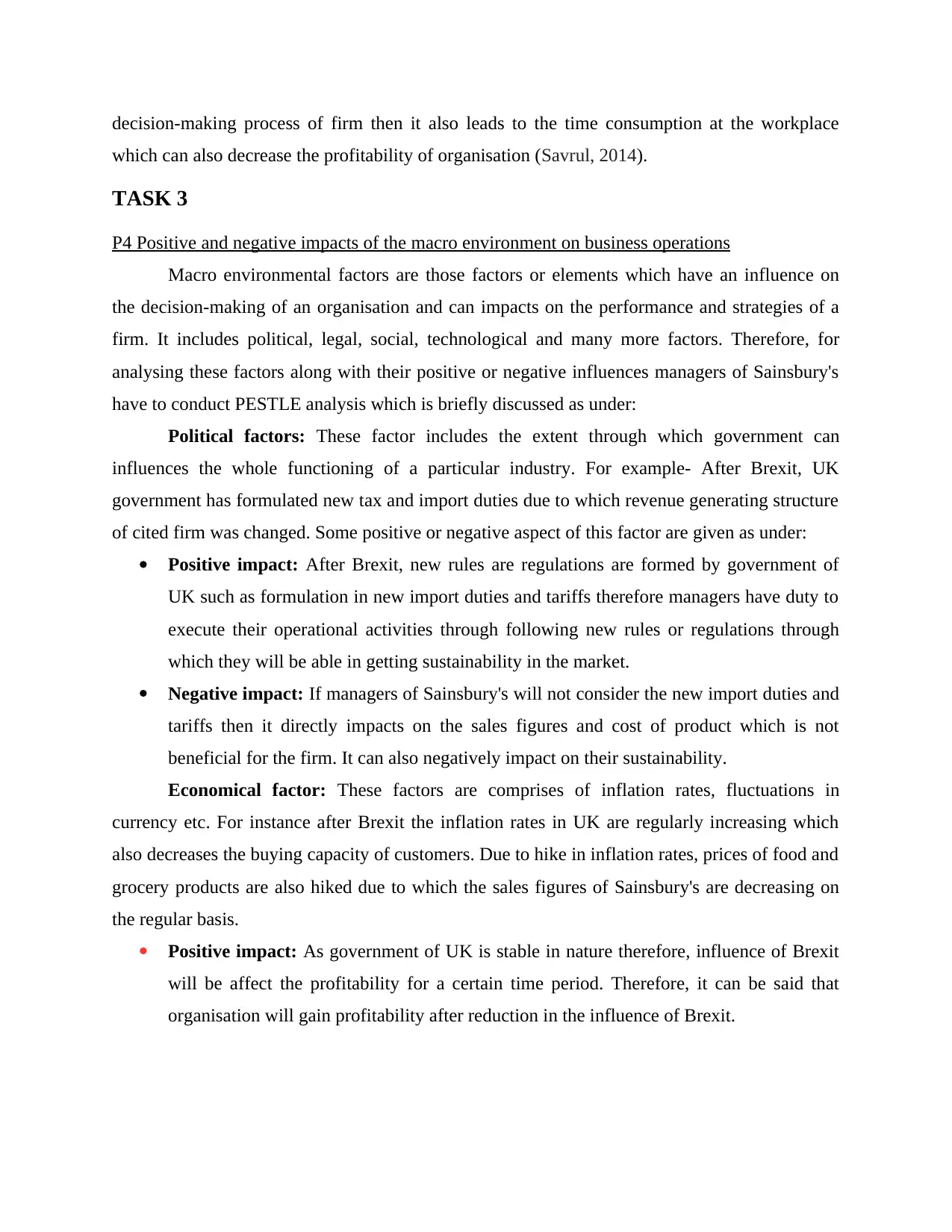
decision-making process of firm then it also leads to the time consumption at the workplace
which can also decrease the profitability of organisation (Savrul, 2014).
TASK 3
P4 Positive and negative impacts of the macro environment on business operations
Macro environmental factors are those factors or elements which have an influence on
the decision-making of an organisation and can impacts on the performance and strategies of a
firm. It includes political, legal, social, technological and many more factors. Therefore, for
analysing these factors along with their positive or negative influences managers of Sainsbury's
have to conduct PESTLE analysis which is briefly discussed as under:
Political factors: These factor includes the extent through which government can
influences the whole functioning of a particular industry. For example- After Brexit, UK
government has formulated new tax and import duties due to which revenue generating structure
of cited firm was changed. Some positive or negative aspect of this factor are given as under:
Positive impact: After Brexit, new rules are regulations are formed by government of
UK such as formulation in new import duties and tariffs therefore managers have duty to
execute their operational activities through following new rules or regulations through
which they will be able in getting sustainability in the market.
Negative impact: If managers of Sainsbury's will not consider the new import duties and
tariffs then it directly impacts on the sales figures and cost of product which is not
beneficial for the firm. It can also negatively impact on their sustainability.
Economical factor: These factors are comprises of inflation rates, fluctuations in
currency etc. For instance after Brexit the inflation rates in UK are regularly increasing which
also decreases the buying capacity of customers. Due to hike in inflation rates, prices of food and
grocery products are also hiked due to which the sales figures of Sainsbury's are decreasing on
the regular basis.
Positive impact: As government of UK is stable in nature therefore, influence of Brexit
will be affect the profitability for a certain time period. Therefore, it can be said that
organisation will gain profitability after reduction in the influence of Brexit.
which can also decrease the profitability of organisation (Savrul, 2014).
TASK 3
P4 Positive and negative impacts of the macro environment on business operations
Macro environmental factors are those factors or elements which have an influence on
the decision-making of an organisation and can impacts on the performance and strategies of a
firm. It includes political, legal, social, technological and many more factors. Therefore, for
analysing these factors along with their positive or negative influences managers of Sainsbury's
have to conduct PESTLE analysis which is briefly discussed as under:
Political factors: These factor includes the extent through which government can
influences the whole functioning of a particular industry. For example- After Brexit, UK
government has formulated new tax and import duties due to which revenue generating structure
of cited firm was changed. Some positive or negative aspect of this factor are given as under:
Positive impact: After Brexit, new rules are regulations are formed by government of
UK such as formulation in new import duties and tariffs therefore managers have duty to
execute their operational activities through following new rules or regulations through
which they will be able in getting sustainability in the market.
Negative impact: If managers of Sainsbury's will not consider the new import duties and
tariffs then it directly impacts on the sales figures and cost of product which is not
beneficial for the firm. It can also negatively impact on their sustainability.
Economical factor: These factors are comprises of inflation rates, fluctuations in
currency etc. For instance after Brexit the inflation rates in UK are regularly increasing which
also decreases the buying capacity of customers. Due to hike in inflation rates, prices of food and
grocery products are also hiked due to which the sales figures of Sainsbury's are decreasing on
the regular basis.
Positive impact: As government of UK is stable in nature therefore, influence of Brexit
will be affect the profitability for a certain time period. Therefore, it can be said that
organisation will gain profitability after reduction in the influence of Brexit.
Secure Best Marks with AI Grader
Need help grading? Try our AI Grader for instant feedback on your assignments.
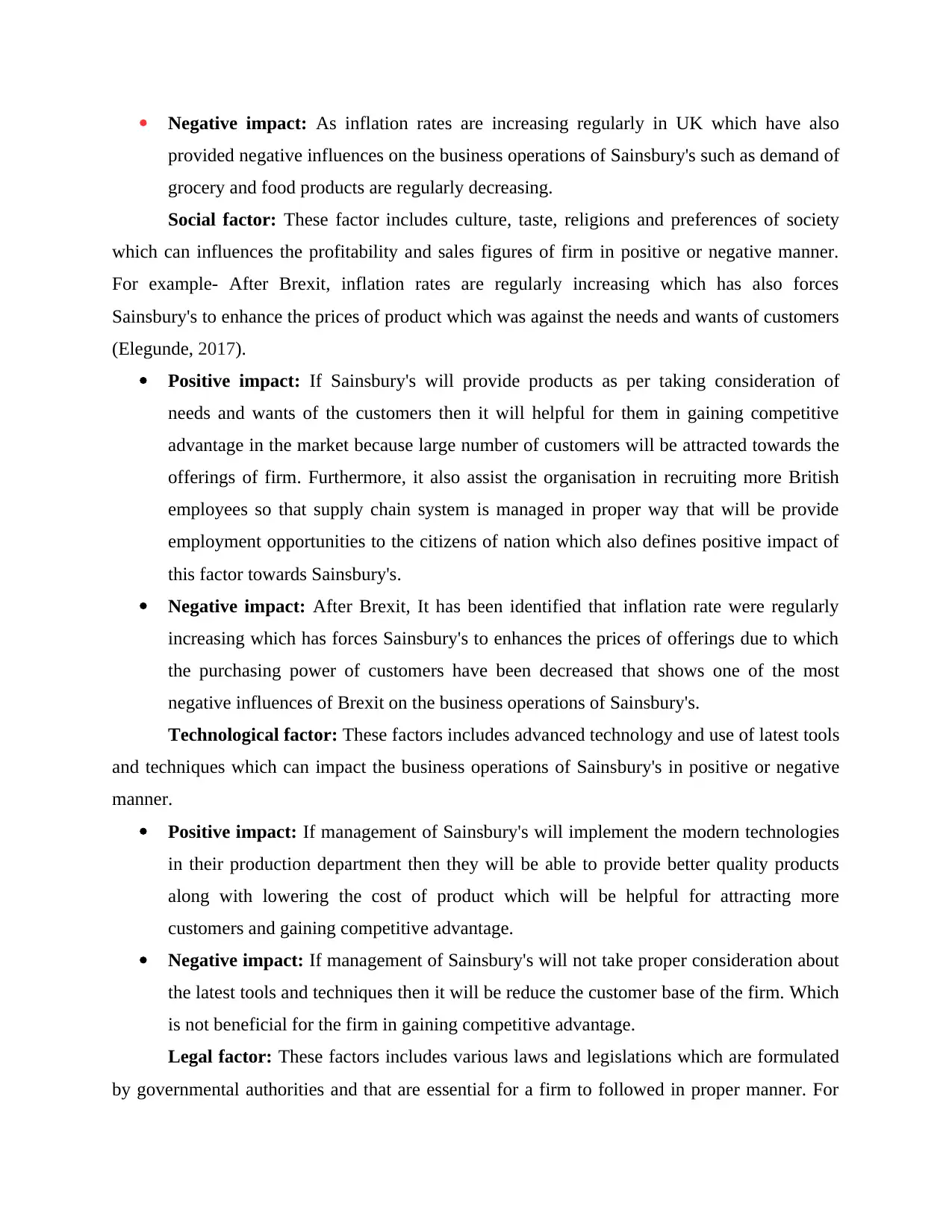
Negative impact: As inflation rates are increasing regularly in UK which have also
provided negative influences on the business operations of Sainsbury's such as demand of
grocery and food products are regularly decreasing.
Social factor: These factor includes culture, taste, religions and preferences of society
which can influences the profitability and sales figures of firm in positive or negative manner.
For example- After Brexit, inflation rates are regularly increasing which has also forces
Sainsbury's to enhance the prices of product which was against the needs and wants of customers
(Elegunde, 2017).
Positive impact: If Sainsbury's will provide products as per taking consideration of
needs and wants of the customers then it will helpful for them in gaining competitive
advantage in the market because large number of customers will be attracted towards the
offerings of firm. Furthermore, it also assist the organisation in recruiting more British
employees so that supply chain system is managed in proper way that will be provide
employment opportunities to the citizens of nation which also defines positive impact of
this factor towards Sainsbury's.
Negative impact: After Brexit, It has been identified that inflation rate were regularly
increasing which has forces Sainsbury's to enhances the prices of offerings due to which
the purchasing power of customers have been decreased that shows one of the most
negative influences of Brexit on the business operations of Sainsbury's.
Technological factor: These factors includes advanced technology and use of latest tools
and techniques which can impact the business operations of Sainsbury's in positive or negative
manner.
Positive impact: If management of Sainsbury's will implement the modern technologies
in their production department then they will be able to provide better quality products
along with lowering the cost of product which will be helpful for attracting more
customers and gaining competitive advantage.
Negative impact: If management of Sainsbury's will not take proper consideration about
the latest tools and techniques then it will be reduce the customer base of the firm. Which
is not beneficial for the firm in gaining competitive advantage.
Legal factor: These factors includes various laws and legislations which are formulated
by governmental authorities and that are essential for a firm to followed in proper manner. For
provided negative influences on the business operations of Sainsbury's such as demand of
grocery and food products are regularly decreasing.
Social factor: These factor includes culture, taste, religions and preferences of society
which can influences the profitability and sales figures of firm in positive or negative manner.
For example- After Brexit, inflation rates are regularly increasing which has also forces
Sainsbury's to enhance the prices of product which was against the needs and wants of customers
(Elegunde, 2017).
Positive impact: If Sainsbury's will provide products as per taking consideration of
needs and wants of the customers then it will helpful for them in gaining competitive
advantage in the market because large number of customers will be attracted towards the
offerings of firm. Furthermore, it also assist the organisation in recruiting more British
employees so that supply chain system is managed in proper way that will be provide
employment opportunities to the citizens of nation which also defines positive impact of
this factor towards Sainsbury's.
Negative impact: After Brexit, It has been identified that inflation rate were regularly
increasing which has forces Sainsbury's to enhances the prices of offerings due to which
the purchasing power of customers have been decreased that shows one of the most
negative influences of Brexit on the business operations of Sainsbury's.
Technological factor: These factors includes advanced technology and use of latest tools
and techniques which can impact the business operations of Sainsbury's in positive or negative
manner.
Positive impact: If management of Sainsbury's will implement the modern technologies
in their production department then they will be able to provide better quality products
along with lowering the cost of product which will be helpful for attracting more
customers and gaining competitive advantage.
Negative impact: If management of Sainsbury's will not take proper consideration about
the latest tools and techniques then it will be reduce the customer base of the firm. Which
is not beneficial for the firm in gaining competitive advantage.
Legal factor: These factors includes various laws and legislations which are formulated
by governmental authorities and that are essential for a firm to followed in proper manner. For
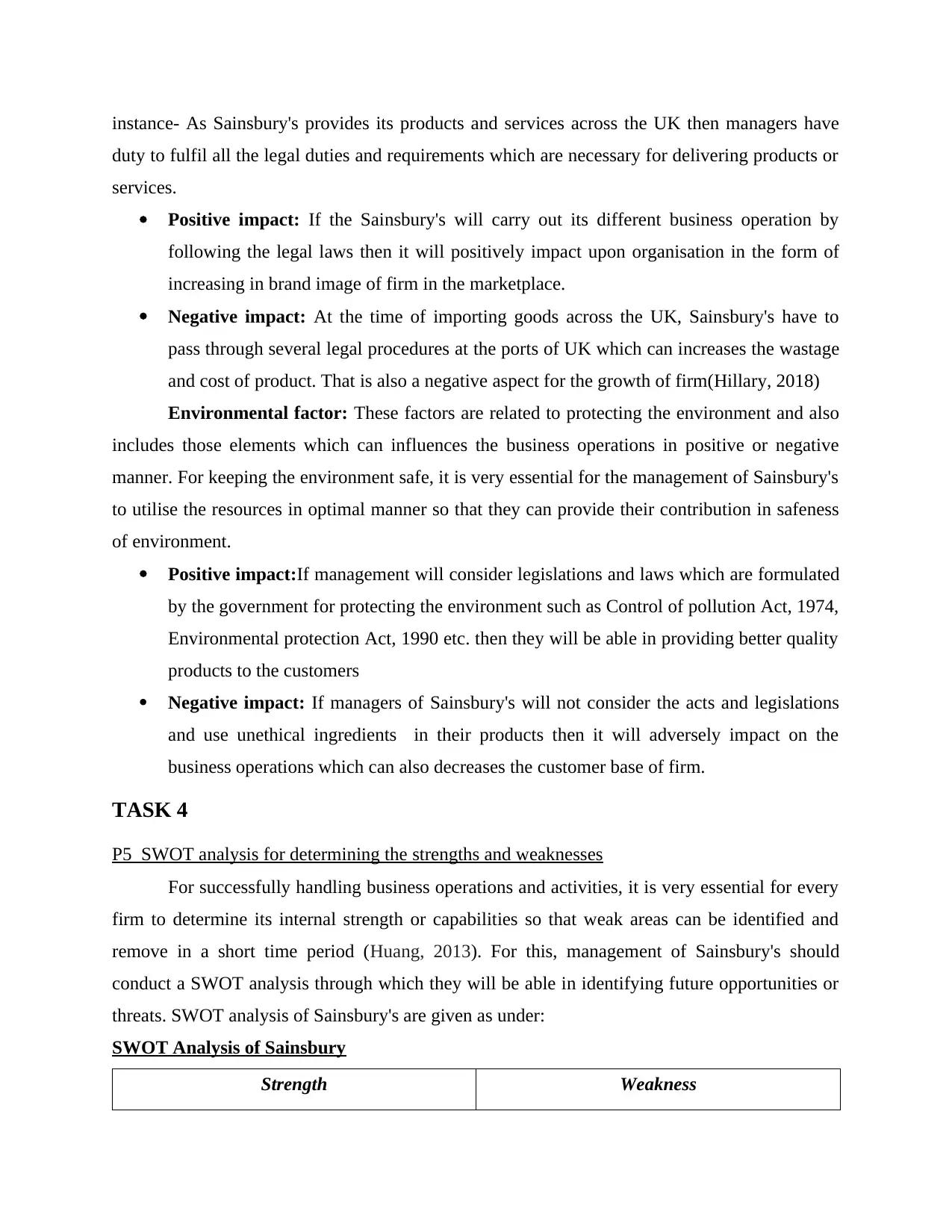
instance- As Sainsbury's provides its products and services across the UK then managers have
duty to fulfil all the legal duties and requirements which are necessary for delivering products or
services.
Positive impact: If the Sainsbury's will carry out its different business operation by
following the legal laws then it will positively impact upon organisation in the form of
increasing in brand image of firm in the marketplace.
Negative impact: At the time of importing goods across the UK, Sainsbury's have to
pass through several legal procedures at the ports of UK which can increases the wastage
and cost of product. That is also a negative aspect for the growth of firm(Hillary, 2018)
Environmental factor: These factors are related to protecting the environment and also
includes those elements which can influences the business operations in positive or negative
manner. For keeping the environment safe, it is very essential for the management of Sainsbury's
to utilise the resources in optimal manner so that they can provide their contribution in safeness
of environment.
Positive impact:If management will consider legislations and laws which are formulated
by the government for protecting the environment such as Control of pollution Act, 1974,
Environmental protection Act, 1990 etc. then they will be able in providing better quality
products to the customers
Negative impact: If managers of Sainsbury's will not consider the acts and legislations
and use unethical ingredients in their products then it will adversely impact on the
business operations which can also decreases the customer base of firm.
TASK 4
P5 SWOT analysis for determining the strengths and weaknesses
For successfully handling business operations and activities, it is very essential for every
firm to determine its internal strength or capabilities so that weak areas can be identified and
remove in a short time period (Huang, 2013). For this, management of Sainsbury's should
conduct a SWOT analysis through which they will be able in identifying future opportunities or
threats. SWOT analysis of Sainsbury's are given as under:
SWOT Analysis of Sainsbury
Strength Weakness
duty to fulfil all the legal duties and requirements which are necessary for delivering products or
services.
Positive impact: If the Sainsbury's will carry out its different business operation by
following the legal laws then it will positively impact upon organisation in the form of
increasing in brand image of firm in the marketplace.
Negative impact: At the time of importing goods across the UK, Sainsbury's have to
pass through several legal procedures at the ports of UK which can increases the wastage
and cost of product. That is also a negative aspect for the growth of firm(Hillary, 2018)
Environmental factor: These factors are related to protecting the environment and also
includes those elements which can influences the business operations in positive or negative
manner. For keeping the environment safe, it is very essential for the management of Sainsbury's
to utilise the resources in optimal manner so that they can provide their contribution in safeness
of environment.
Positive impact:If management will consider legislations and laws which are formulated
by the government for protecting the environment such as Control of pollution Act, 1974,
Environmental protection Act, 1990 etc. then they will be able in providing better quality
products to the customers
Negative impact: If managers of Sainsbury's will not consider the acts and legislations
and use unethical ingredients in their products then it will adversely impact on the
business operations which can also decreases the customer base of firm.
TASK 4
P5 SWOT analysis for determining the strengths and weaknesses
For successfully handling business operations and activities, it is very essential for every
firm to determine its internal strength or capabilities so that weak areas can be identified and
remove in a short time period (Huang, 2013). For this, management of Sainsbury's should
conduct a SWOT analysis through which they will be able in identifying future opportunities or
threats. SWOT analysis of Sainsbury's are given as under:
SWOT Analysis of Sainsbury
Strength Weakness
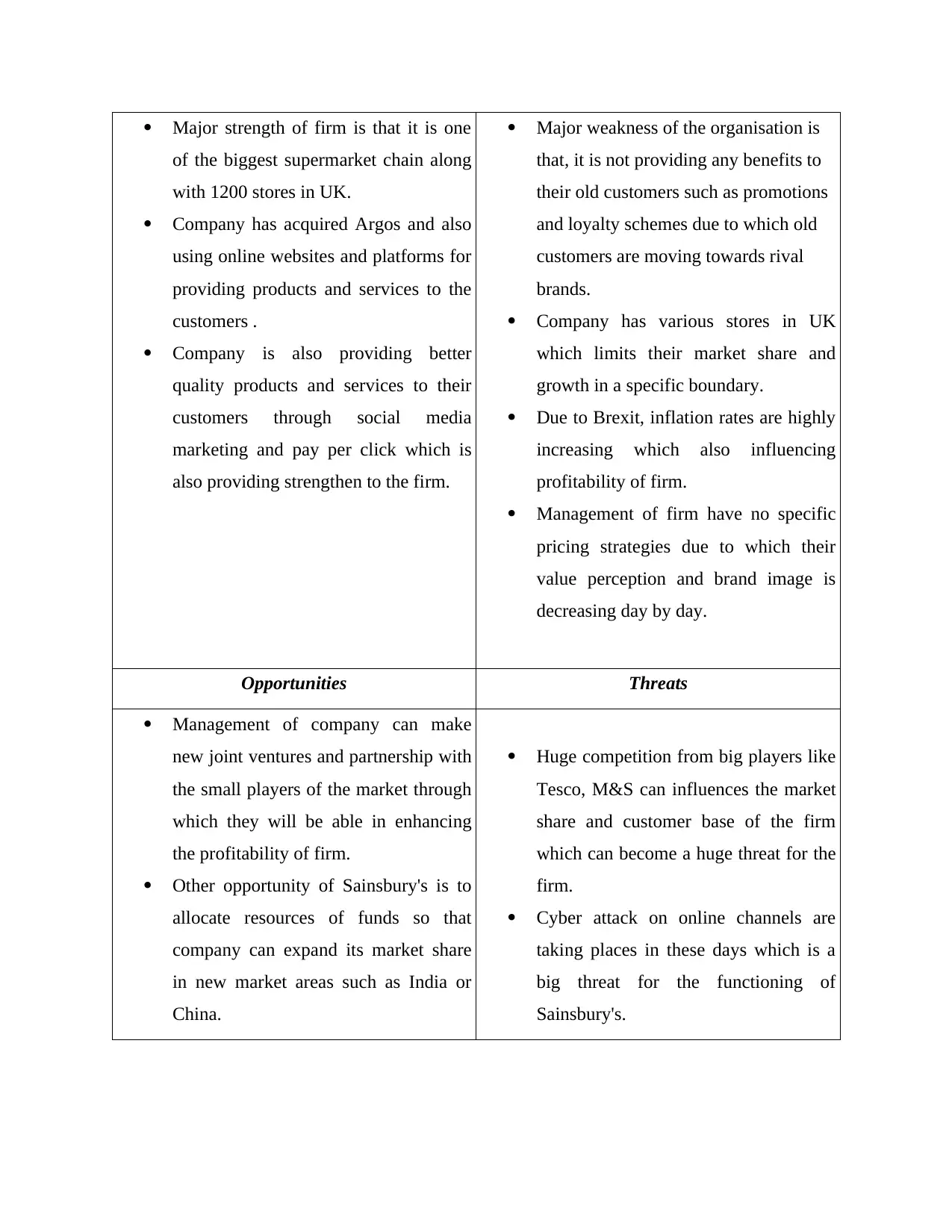
Major strength of firm is that it is one
of the biggest supermarket chain along
with 1200 stores in UK.
Company has acquired Argos and also
using online websites and platforms for
providing products and services to the
customers .
Company is also providing better
quality products and services to their
customers through social media
marketing and pay per click which is
also providing strengthen to the firm.
Major weakness of the organisation is
that, it is not providing any benefits to
their old customers such as promotions
and loyalty schemes due to which old
customers are moving towards rival
brands.
Company has various stores in UK
which limits their market share and
growth in a specific boundary.
Due to Brexit, inflation rates are highly
increasing which also influencing
profitability of firm.
Management of firm have no specific
pricing strategies due to which their
value perception and brand image is
decreasing day by day.
Opportunities Threats
Management of company can make
new joint ventures and partnership with
the small players of the market through
which they will be able in enhancing
the profitability of firm.
Other opportunity of Sainsbury's is to
allocate resources of funds so that
company can expand its market share
in new market areas such as India or
China.
Huge competition from big players like
Tesco, M&S can influences the market
share and customer base of the firm
which can become a huge threat for the
firm.
Cyber attack on online channels are
taking places in these days which is a
big threat for the functioning of
Sainsbury's.
of the biggest supermarket chain along
with 1200 stores in UK.
Company has acquired Argos and also
using online websites and platforms for
providing products and services to the
customers .
Company is also providing better
quality products and services to their
customers through social media
marketing and pay per click which is
also providing strengthen to the firm.
Major weakness of the organisation is
that, it is not providing any benefits to
their old customers such as promotions
and loyalty schemes due to which old
customers are moving towards rival
brands.
Company has various stores in UK
which limits their market share and
growth in a specific boundary.
Due to Brexit, inflation rates are highly
increasing which also influencing
profitability of firm.
Management of firm have no specific
pricing strategies due to which their
value perception and brand image is
decreasing day by day.
Opportunities Threats
Management of company can make
new joint ventures and partnership with
the small players of the market through
which they will be able in enhancing
the profitability of firm.
Other opportunity of Sainsbury's is to
allocate resources of funds so that
company can expand its market share
in new market areas such as India or
China.
Huge competition from big players like
Tesco, M&S can influences the market
share and customer base of the firm
which can become a huge threat for the
firm.
Cyber attack on online channels are
taking places in these days which is a
big threat for the functioning of
Sainsbury's.
Paraphrase This Document
Need a fresh take? Get an instant paraphrase of this document with our AI Paraphraser
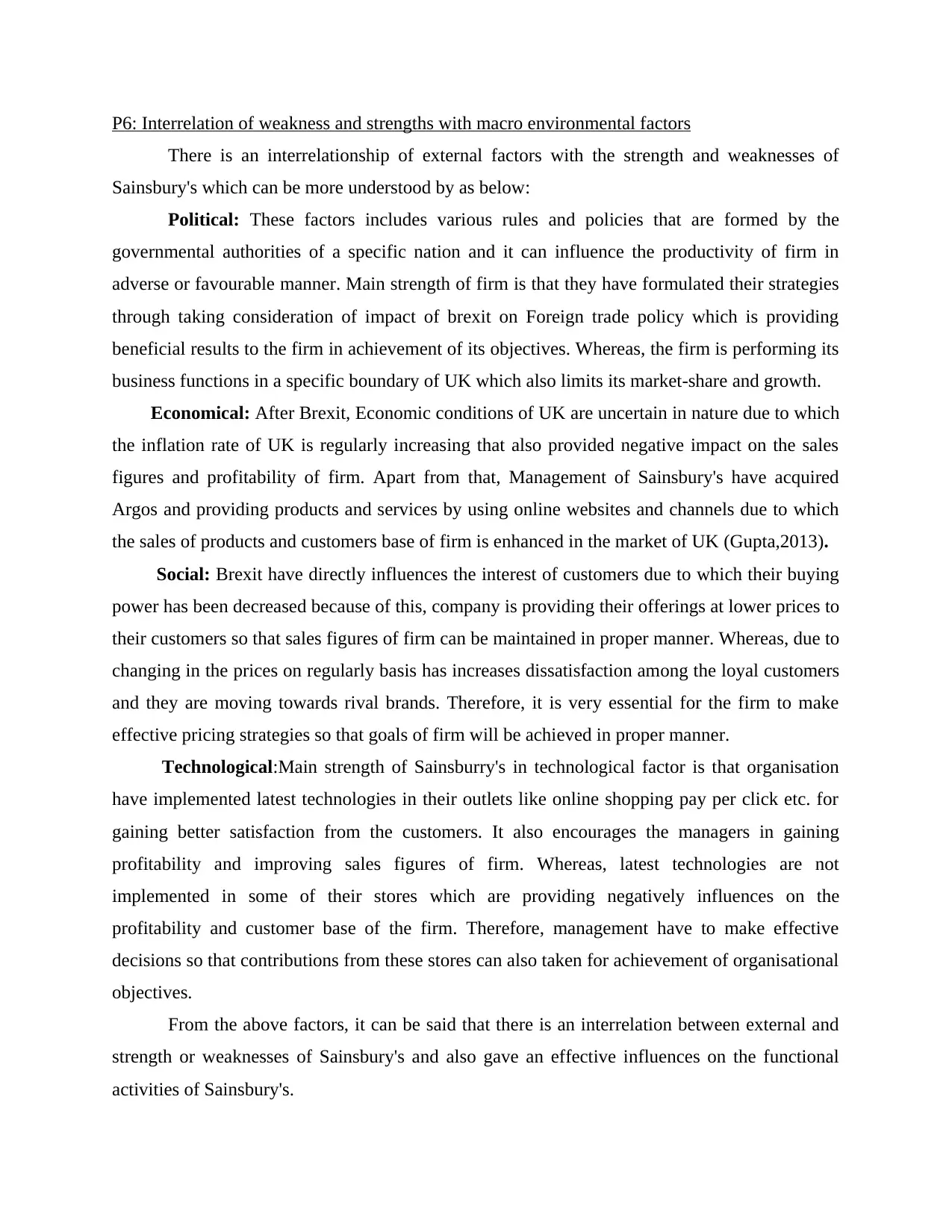
P6: Interrelation of weakness and strengths with macro environmental factors
There is an interrelationship of external factors with the strength and weaknesses of
Sainsbury's which can be more understood by as below:
Political: These factors includes various rules and policies that are formed by the
governmental authorities of a specific nation and it can influence the productivity of firm in
adverse or favourable manner. Main strength of firm is that they have formulated their strategies
through taking consideration of impact of brexit on Foreign trade policy which is providing
beneficial results to the firm in achievement of its objectives. Whereas, the firm is performing its
business functions in a specific boundary of UK which also limits its market-share and growth.
Economical: After Brexit, Economic conditions of UK are uncertain in nature due to which
the inflation rate of UK is regularly increasing that also provided negative impact on the sales
figures and profitability of firm. Apart from that, Management of Sainsbury's have acquired
Argos and providing products and services by using online websites and channels due to which
the sales of products and customers base of firm is enhanced in the market of UK (Gupta,2013).
Social: Brexit have directly influences the interest of customers due to which their buying
power has been decreased because of this, company is providing their offerings at lower prices to
their customers so that sales figures of firm can be maintained in proper manner. Whereas, due to
changing in the prices on regularly basis has increases dissatisfaction among the loyal customers
and they are moving towards rival brands. Therefore, it is very essential for the firm to make
effective pricing strategies so that goals of firm will be achieved in proper manner.
Technological:Main strength of Sainsburry's in technological factor is that organisation
have implemented latest technologies in their outlets like online shopping pay per click etc. for
gaining better satisfaction from the customers. It also encourages the managers in gaining
profitability and improving sales figures of firm. Whereas, latest technologies are not
implemented in some of their stores which are providing negatively influences on the
profitability and customer base of the firm. Therefore, management have to make effective
decisions so that contributions from these stores can also taken for achievement of organisational
objectives.
From the above factors, it can be said that there is an interrelation between external and
strength or weaknesses of Sainsbury's and also gave an effective influences on the functional
activities of Sainsbury's.
There is an interrelationship of external factors with the strength and weaknesses of
Sainsbury's which can be more understood by as below:
Political: These factors includes various rules and policies that are formed by the
governmental authorities of a specific nation and it can influence the productivity of firm in
adverse or favourable manner. Main strength of firm is that they have formulated their strategies
through taking consideration of impact of brexit on Foreign trade policy which is providing
beneficial results to the firm in achievement of its objectives. Whereas, the firm is performing its
business functions in a specific boundary of UK which also limits its market-share and growth.
Economical: After Brexit, Economic conditions of UK are uncertain in nature due to which
the inflation rate of UK is regularly increasing that also provided negative impact on the sales
figures and profitability of firm. Apart from that, Management of Sainsbury's have acquired
Argos and providing products and services by using online websites and channels due to which
the sales of products and customers base of firm is enhanced in the market of UK (Gupta,2013).
Social: Brexit have directly influences the interest of customers due to which their buying
power has been decreased because of this, company is providing their offerings at lower prices to
their customers so that sales figures of firm can be maintained in proper manner. Whereas, due to
changing in the prices on regularly basis has increases dissatisfaction among the loyal customers
and they are moving towards rival brands. Therefore, it is very essential for the firm to make
effective pricing strategies so that goals of firm will be achieved in proper manner.
Technological:Main strength of Sainsburry's in technological factor is that organisation
have implemented latest technologies in their outlets like online shopping pay per click etc. for
gaining better satisfaction from the customers. It also encourages the managers in gaining
profitability and improving sales figures of firm. Whereas, latest technologies are not
implemented in some of their stores which are providing negatively influences on the
profitability and customer base of the firm. Therefore, management have to make effective
decisions so that contributions from these stores can also taken for achievement of organisational
objectives.
From the above factors, it can be said that there is an interrelation between external and
strength or weaknesses of Sainsbury's and also gave an effective influences on the functional
activities of Sainsbury's.
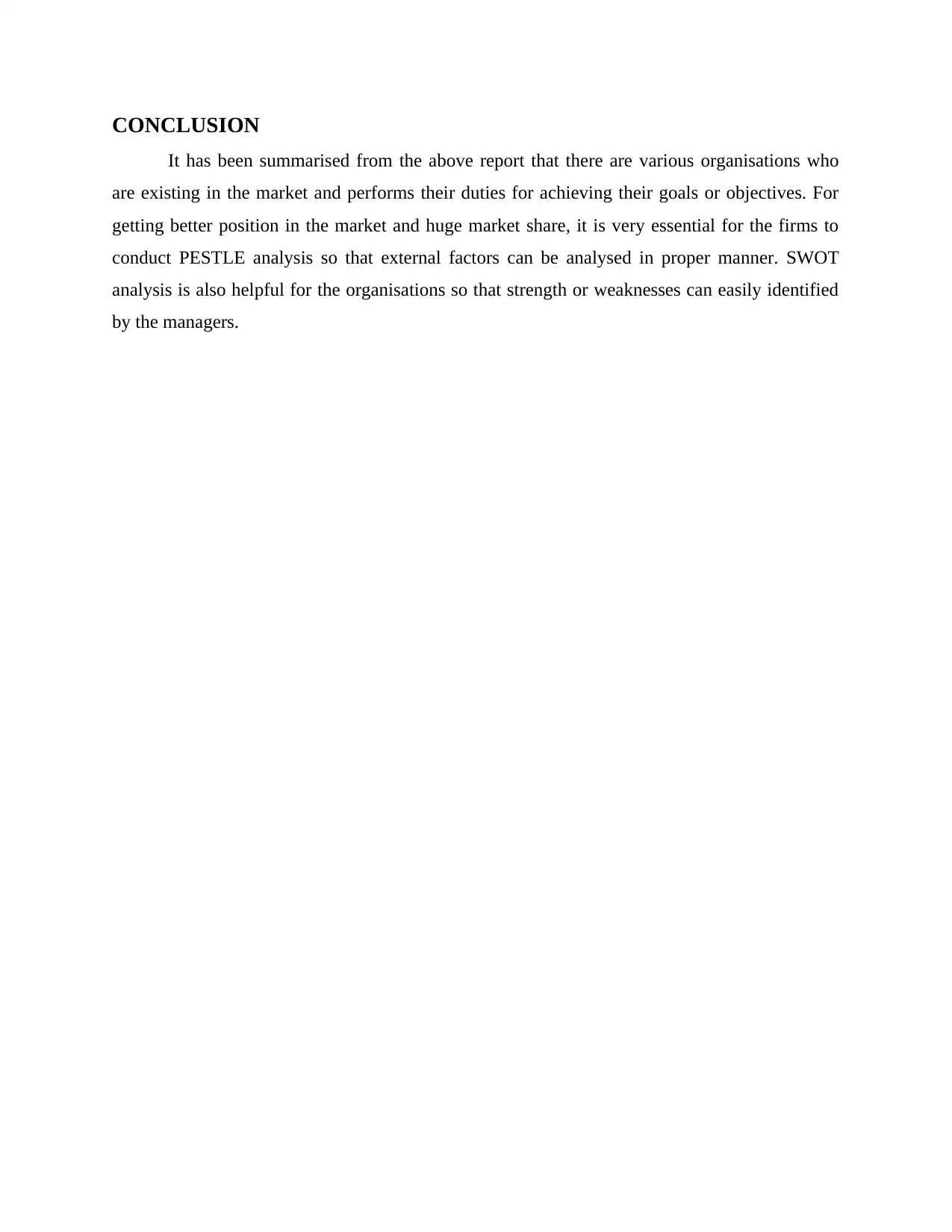
CONCLUSION
It has been summarised from the above report that there are various organisations who
are existing in the market and performs their duties for achieving their goals or objectives. For
getting better position in the market and huge market share, it is very essential for the firms to
conduct PESTLE analysis so that external factors can be analysed in proper manner. SWOT
analysis is also helpful for the organisations so that strength or weaknesses can easily identified
by the managers.
It has been summarised from the above report that there are various organisations who
are existing in the market and performs their duties for achieving their goals or objectives. For
getting better position in the market and huge market share, it is very essential for the firms to
conduct PESTLE analysis so that external factors can be analysed in proper manner. SWOT
analysis is also helpful for the organisations so that strength or weaknesses can easily identified
by the managers.
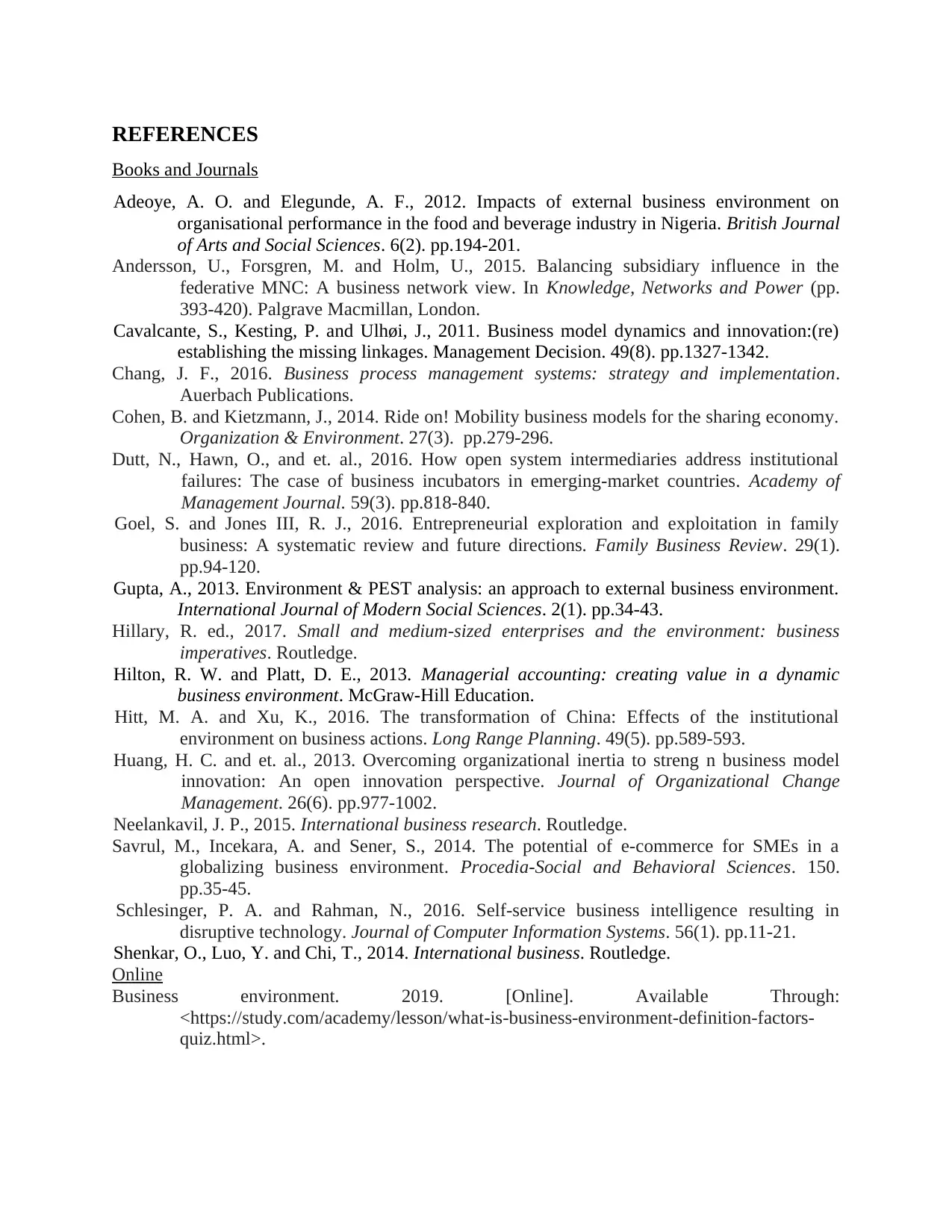
REFERENCES
Books and Journals
Adeoye, A. O. and Elegunde, A. F., 2012. Impacts of external business environment on
organisational performance in the food and beverage industry in Nigeria. British Journal
of Arts and Social Sciences. 6(2). pp.194-201.
Andersson, U., Forsgren, M. and Holm, U., 2015. Balancing subsidiary influence in the
federative MNC: A business network view. In Knowledge, Networks and Power (pp.
393-420). Palgrave Macmillan, London.
Cavalcante, S., Kesting, P. and Ulhøi, J., 2011. Business model dynamics and innovation:(re)
establishing the missing linkages. Management Decision. 49(8). pp.1327-1342.
Chang, J. F., 2016. Business process management systems: strategy and implementation.
Auerbach Publications.
Cohen, B. and Kietzmann, J., 2014. Ride on! Mobility business models for the sharing economy.
Organization & Environment. 27(3). pp.279-296.
Dutt, N., Hawn, O., and et. al., 2016. How open system intermediaries address institutional
failures: The case of business incubators in emerging-market countries. Academy of
Management Journal. 59(3). pp.818-840.
Goel, S. and Jones III, R. J., 2016. Entrepreneurial exploration and exploitation in family
business: A systematic review and future directions. Family Business Review. 29(1).
pp.94-120.
Gupta, A., 2013. Environment & PEST analysis: an approach to external business environment.
International Journal of Modern Social Sciences. 2(1). pp.34-43.
Hillary, R. ed., 2017. Small and medium-sized enterprises and the environment: business
imperatives. Routledge.
Hilton, R. W. and Platt, D. E., 2013. Managerial accounting: creating value in a dynamic
business environment. McGraw-Hill Education.
Hitt, M. A. and Xu, K., 2016. The transformation of China: Effects of the institutional
environment on business actions. Long Range Planning. 49(5). pp.589-593.
Huang, H. C. and et. al., 2013. Overcoming organizational inertia to streng n business model
innovation: An open innovation perspective. Journal of Organizational Change
Management. 26(6). pp.977-1002.
Neelankavil, J. P., 2015. International business research. Routledge.
Savrul, M., Incekara, A. and Sener, S., 2014. The potential of e-commerce for SMEs in a
globalizing business environment. Procedia-Social and Behavioral Sciences. 150.
pp.35-45.
Schlesinger, P. A. and Rahman, N., 2016. Self-service business intelligence resulting in
disruptive technology. Journal of Computer Information Systems. 56(1). pp.11-21.
Shenkar, O., Luo, Y. and Chi, T., 2014. International business. Routledge.
Online
Business environment. 2019. [Online]. Available Through:
<https://study.com/academy/lesson/what-is-business-environment-definition-factors-
quiz.html>.
Books and Journals
Adeoye, A. O. and Elegunde, A. F., 2012. Impacts of external business environment on
organisational performance in the food and beverage industry in Nigeria. British Journal
of Arts and Social Sciences. 6(2). pp.194-201.
Andersson, U., Forsgren, M. and Holm, U., 2015. Balancing subsidiary influence in the
federative MNC: A business network view. In Knowledge, Networks and Power (pp.
393-420). Palgrave Macmillan, London.
Cavalcante, S., Kesting, P. and Ulhøi, J., 2011. Business model dynamics and innovation:(re)
establishing the missing linkages. Management Decision. 49(8). pp.1327-1342.
Chang, J. F., 2016. Business process management systems: strategy and implementation.
Auerbach Publications.
Cohen, B. and Kietzmann, J., 2014. Ride on! Mobility business models for the sharing economy.
Organization & Environment. 27(3). pp.279-296.
Dutt, N., Hawn, O., and et. al., 2016. How open system intermediaries address institutional
failures: The case of business incubators in emerging-market countries. Academy of
Management Journal. 59(3). pp.818-840.
Goel, S. and Jones III, R. J., 2016. Entrepreneurial exploration and exploitation in family
business: A systematic review and future directions. Family Business Review. 29(1).
pp.94-120.
Gupta, A., 2013. Environment & PEST analysis: an approach to external business environment.
International Journal of Modern Social Sciences. 2(1). pp.34-43.
Hillary, R. ed., 2017. Small and medium-sized enterprises and the environment: business
imperatives. Routledge.
Hilton, R. W. and Platt, D. E., 2013. Managerial accounting: creating value in a dynamic
business environment. McGraw-Hill Education.
Hitt, M. A. and Xu, K., 2016. The transformation of China: Effects of the institutional
environment on business actions. Long Range Planning. 49(5). pp.589-593.
Huang, H. C. and et. al., 2013. Overcoming organizational inertia to streng n business model
innovation: An open innovation perspective. Journal of Organizational Change
Management. 26(6). pp.977-1002.
Neelankavil, J. P., 2015. International business research. Routledge.
Savrul, M., Incekara, A. and Sener, S., 2014. The potential of e-commerce for SMEs in a
globalizing business environment. Procedia-Social and Behavioral Sciences. 150.
pp.35-45.
Schlesinger, P. A. and Rahman, N., 2016. Self-service business intelligence resulting in
disruptive technology. Journal of Computer Information Systems. 56(1). pp.11-21.
Shenkar, O., Luo, Y. and Chi, T., 2014. International business. Routledge.
Online
Business environment. 2019. [Online]. Available Through:
<https://study.com/academy/lesson/what-is-business-environment-definition-factors-
quiz.html>.
1 out of 16
Related Documents
Your All-in-One AI-Powered Toolkit for Academic Success.
+13062052269
info@desklib.com
Available 24*7 on WhatsApp / Email
![[object Object]](/_next/static/media/star-bottom.7253800d.svg)
Unlock your academic potential
© 2024 | Zucol Services PVT LTD | All rights reserved.





